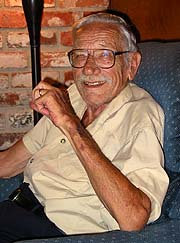|
      
|
June 24, 2002
Ecologist Ray Dasmann's memoir Called by the Wild traces birth of environmentalism
By Jennifer McNulty
Raymond Dasmann's self-deprecating humor and gift for understatement belie his role
as a pioneering environmentalist. Dasmann's new memoir, Called by the Wild: The
Autobiography of a Conservationist (Berkeley, CA: University of California, Press,
2002), reflects his desire to give credit to others, but in fact Dasmann is one of
a handful of visionaries who gave life to the worldwide environmental movement.
 |
| In Called by the Wild, Raymond Dasmann identifies the major threats
of population growth, pollution, habitat loss, and species eradication. Photo: Jennifer McNulty |
Dasmann, professor emeritus of ecology at UC Santa Cruz, is among those academics
whose talent for scientific research is matched by his desire to change the world.
A gifted writer equally at home in the field, the classroom, and the policy arena,
Dasmann translated his passion for nature into a vision of planet preservation years
before the public began to grapple with concepts like conservation and overpopulation.
Called by the Wild tells the story of an exceptional man's life in a most
unpretentious way, beginning with Dasmann's childhood adventures in San Francisco,
followed by his service during World War II, his marriage to Elizabeth Sheldon, his
work as a field biologist, and his role at the forefront of international conservation
efforts, which took him to Africa, Sri Lanka, the Caribbean, and California. Along
the way, Dasmann identifies the major threats of population growth, pollution, habitat
loss, and species eradication and makes an impassioned plea for sustainability on
a planet with limited resources.
The author of more than a dozen books, including The Destruction of California
(1965), Environmental Conservation (fifth edition 1984), Wildlife Biology
(second edition 1981), and California's Changing Environment (1981), Dasmann
began working as a conservation biologist when the field was just emerging. He fought
for the title of his influential text Environmental Conservation at a time
when the phrase was unknown, and his pioneering work on game ranching in Africa fostered
the field of ecodevelopment and helped make ecotourism a household word.
Dasmann's academic contributions at UC Santa Cruz and Humboldt State University are
complemented by the years he spent working with the United Nations Educational, Scientific,
and Cultural Organization (UNESCO), where he helped launch the Man and the Biosphere
program. He also worked with the International Union for the Conservation of Nature
and earned many top awards, including conservation medals from the World Wildlife
Society and the Smithsonian Institution. The prestigious Order of the Golden Ark,
which recognizes the world's most distinguished conservationists, was bestowed on
Dasmann by the Dutch government in 1978.
Although informed by complex scientific observations, Dasmann's vision of conservation
is based on one simple fact: Resources are finite. Yet successful conservation strategies
aren't simple, and Dasmann always fought for policies that took into account the
full complexities of biology. At the Conservation Foundation, he recalled, a senior
official was always chastising Dasmann, saying "Dammit, Dasmann, you keep making
things too complicated! We're just trying to get some land set aside, and you keep
adding all these complications!"
Today, says Dasmann, developing countries are stagnating while the United States
continues to devour the lion's share of the world's resources.
"In the United States, we must get a handle on population growth, and we've
got to get away from this economic order in which growth is tied to consumption,"
he said. "Whether the supply of petroleum is going to run out in 50 years or
20 years or 10 years, the fact that it's going to run out is obvious. We've got to
face up to the limits of growth, because growth is going to be limited whether we
do it voluntarily or not. The growth orientation and the consumerism orientation
is really the basis of the problem."
The public-relations challenges environmentalists face today are similar to those
Dasmann faced as a graduate student studying deer populations in northern California.
Despite convincing data that predicted a population crash unless the number of deer
was reduced, preferably by liberalizing hunting regulations, Dasmann and his colleagues
were unable to build the necessary public support among deer hunters, who believed
a doe hunt would lead to extinction. As a result, the deer population did indeed
crash in the mid-1960s.
For Dasmann, like many scientific researchers who are committed to using research
to inform public policy, the challenge of swaying public opinion remains enormous.
There is little satisfaction in being able to say, "I told you so."
The challenge is to present convincing information, identify simple steps people
can take, and spell out how such efforts will accomplish the desired goal, said Dasmann,
who conceded it's much easier said than done. Comparing the popularity of gas-guzzling
sport-utility vehicles to fuel-efficient hybrid vehicles, he shook his head in disbelief.
"How do you attach prestige to the ecologically most viable object?" he
asked with palms upraised in a gesture suggesting his lifelong quest for the answer.
Return to Front Page 
|
 |